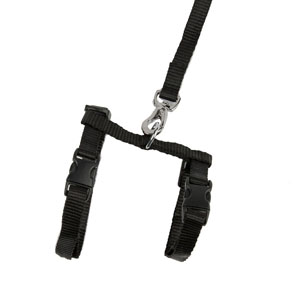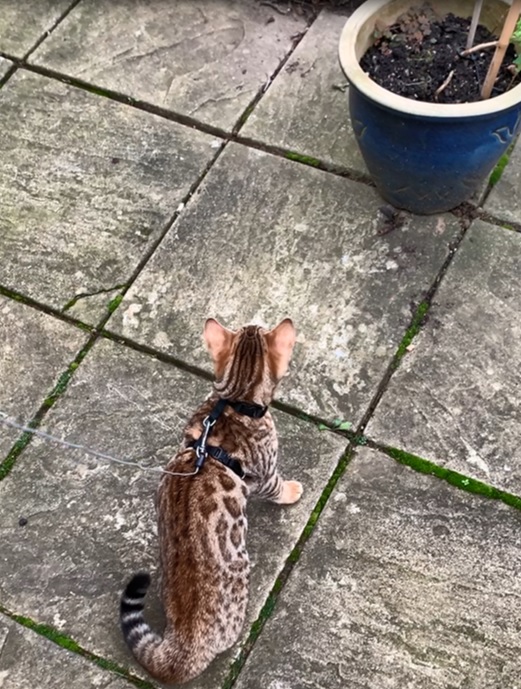The intention all along was for Hazel to be a house cat.
Reasons for this were associated with her safety.
We felt our decision was justified as after reading in this book, we discovered that house cats, on average, live longer than those allowed free access to the outside world (for a more in depth look at this, see the article ‘How Long Do Bengal Cats Live? 12 Excellent Ways To Boost Life Expectancy’).
We’d started work on a ‘catio,’ but this was not yet complete, and not likely to be for the foreseeable future.
However, we knew that Bengals are bright, similar to dogs, and like dogs can be leash trained (see ‘6 Reasons Why a Bengal Cat and Dog Can Get Along‘).
With this mind we thought we’d give it a go to at least allow her some taste of the outdoors.
Choosing and Buying a Harness and Leash
This was the next logical step.
We did some basic research, but most was done when putting together the article ‘The Best Bengal Cat Harness [2021]‘.

I mention in it where we were at the time and how leash training would feature in a future blog post.
So I kept my word…
But back to harnesses and leashes.
We wanted something simple and secure so bought an H-shaped harness like the one pictured (again, see the article to find out exactly what this means and the pros and cons of each type).
It came with a leash, which in all honesty felt too short, so we acquired an extendable/retractable one, like these, and in time, simply attached it to the shorter leash.
Talking of leashes at this stage is actually jumping the gun somewhat, as firstly, one must get their Bengal used to the harness itself….
A Harness in Bed?
The literature suggested that the first step was getting Hazel (or any Bengal of course… they didn’t even know Hazel) to build up familiarity with the harness.
That way, she’d get used to seeing it, its scent would be familiar, and indeed, it would acquire a familiar scent- hers.
That was probably the easiest step, as all we did was leave it on her cat tree, in one of her beds, or on the floor.
We didn’t know exactly when to stop doing this, but felt a few days, on and off, would be enough.
Floppy Kitty
Now actually trying to get her to wear the harness…
In all fairness, it wasn’t too difficult to achieve and was far easier with two people and when distracting Hazel with treats.
She clearly didn’t like having it on and did her best to wriggle out before ‘going floppy’ which supposedly is an instinctive response based on what would happen if they’d been caught by a predator.
It was actually quite amusing.
There was the odd period where she carried on as normal before seeming to remember the ‘predator’ and collapsing to the floor.
The harness was only left on for a few minutes each time, before extending this over the coming weeks and giving her treats/distracting her whilst she was wearing it.
A Leash and a Bolt
With her able to tolerate the harness for longer periods, we thought we’d try and attach the leash- the one that came with the harness only.
We’d read that attaching it, but not holding it, would allow the cat to again become familiar with it, drag it around and give her that freedom of movement.
Well, Hazel bolted a couple of times with no serious outcome as she was in the living room, but it goes to show what could happen if this was done outside with the potential for harm.
Eventually she’d calm down and pull it along as we’d hoped.
Before flopping over again.
The Garden

She’d been out a couple of times already- intentionally, to see how she’d respond to snow and the garden itself, and unintentionally by escaping through opened doors as it’s virtually impossible to maintain lockdown with a Bengal cat 24hrs a day.
As with anything new, there was some apprehension (and some floppiness) but there was enough going on in the outside world to keep her interest away from what she was attached to.
However, interest did mean sprinting after things, which is not a good idea when the leash has a finite length, so naturally she ended up receiving a few sturdy jolts.
We wanted her to lead, so let her explore and smell at her own pace, but she would often follow if we walked in a particular direction, especially if a stick was drawn across the grass or thrown for her to chase.
Taking Her For A ‘Walk’
This didn’t go so well.
A passing car or sight of another human being caused her to bolt into the nearest garden, which happened to be our next door neighbour’s, as this was about has far as we ever got.
The Garden Again
She seemed happy enough in the garden.
We could attached her leash(es) to the washing line, which allowed her to explore large parts of it relatively freely and chase whatever insect happened to cross her path.
Or course this meant having to keep an eye on her most of the time she was out- to make sure she was ok, and to untangle both cat and line.
Putting on the harness became a straight forward exercise and we could adjust the fit with it on her whilst she waited patiently.
Hazel was comfortable with a harness and leash and had limited access to the outside world with all the stimulation that it brought.
But was this going to suffice or even work in the long run… ?
Further Reading:
Please note, Amazon links on this page are affiliate links from which I’ll receive a small percentage if you purchase at no extra cost to you. It all helps. Thanks.




